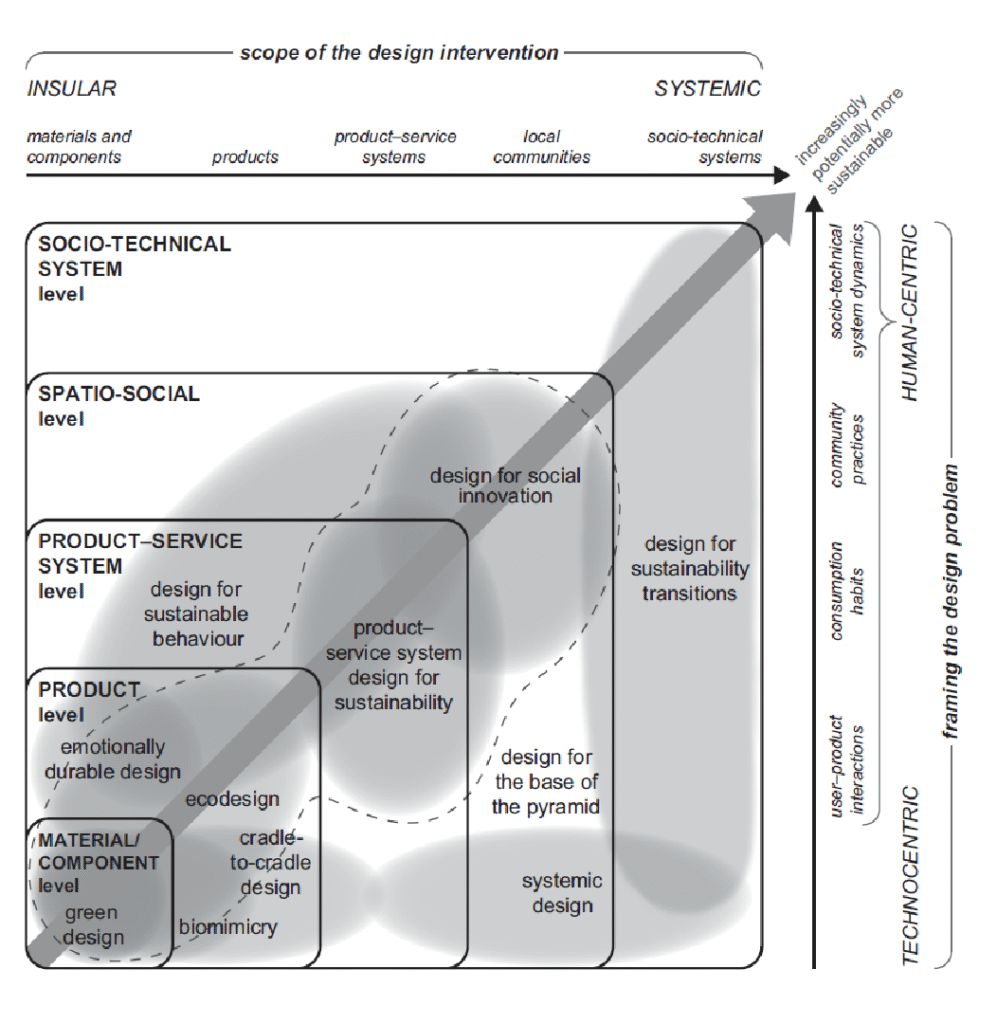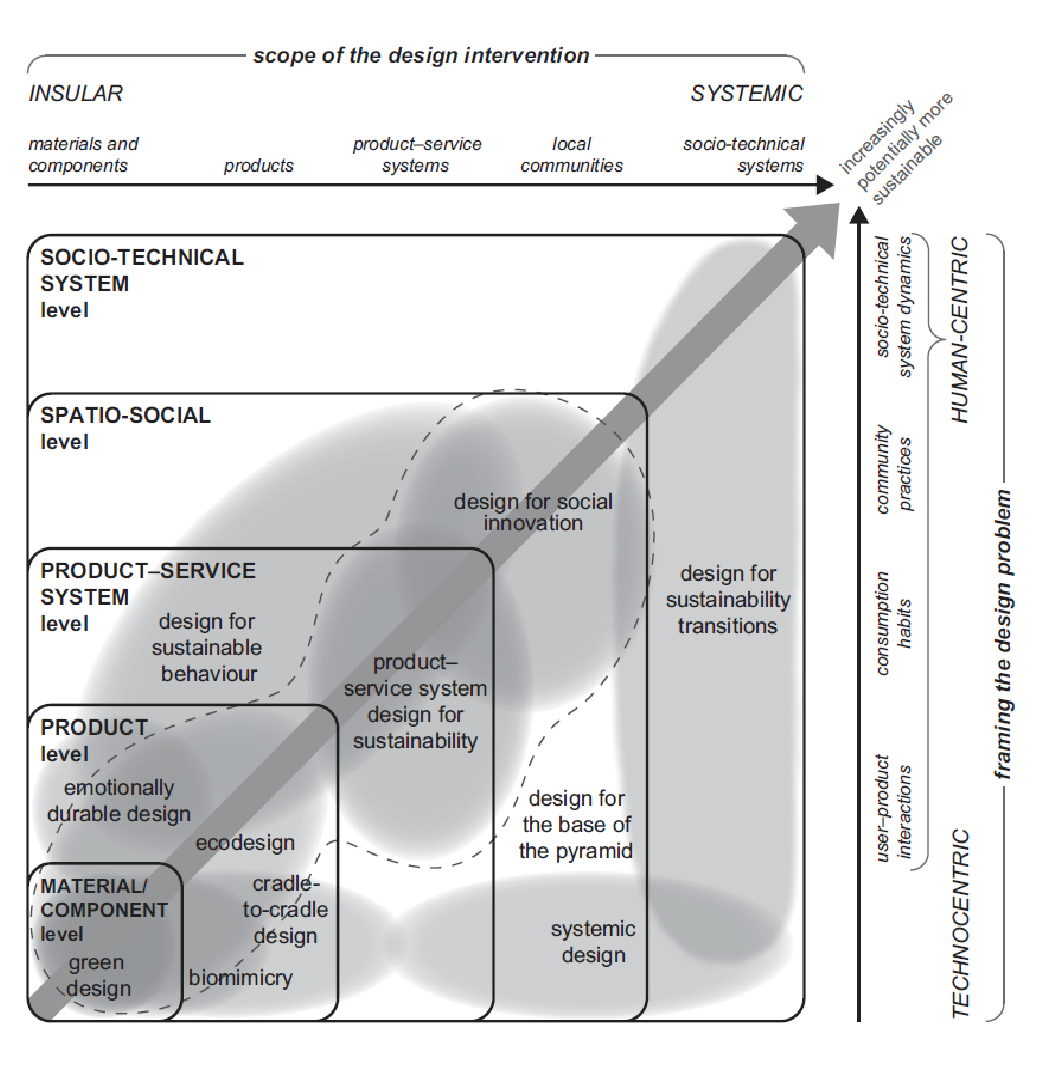
DESIGN FOR SUSTAINABILITY
This page is a videocast created by Master’s and Doctoral students at the Postgraduate Program in Design (PPGDesign) at UFPR, in collaboration with LENS International. In each episode, we explore essential ideas from the book Design for Sustainability by Ceschin and Gaziulusoy (2020), transforming complex academic concepts into short, accessible content for anyone interested in building more sustainable futures through design.
DsF Innovation Framework Overview
The innovation framework proposed in Design for Sustainability serves as a tool to coherently integrate the diverse approaches to Design for Sustainability (DfS) developed over recent decades. It synthesizes the DfS field and its evolution, offering insight into how different approaches contribute to various aspects of sustainability.
The framework is structured around three core components:
1. Five Levels of Innovation + Future
These levels represent the different scales at which design interventions can operate:
- Material/Component Level: Focuses on incremental product improvements through the use of new or alternative materials.
- Product Level: Targets individual products and their life cycles.
- Product–Service System (PSS) Level: Considers the product as part of a broader product–service system.
- Socio-spatial Level: Addresses design interventions within local communities.
- Socio-technical System Level: Aims at the transformation of complex socio-technical systems.
- Future: Socio-technical-Ecological Systems: Oriented toward transitions in progress and post-transition contexts.
2. Horizontal Axis: 'Scope of Design Intervention'
This axis captures the evolution of DfS innovations, ranging from “Insular” to “Systemic.”
Insular refers to innovations that tackle internal company issues. Systemic involves changes across broader socio-economic systems, reaching beyond a company’s immediate boundaries.
3. Vertical Axis: 'Design Problem Framing'
This axis reflects how sustainability problems are conceptualized, spanning from “Technocentric” to “Humancentric.”
A technocentric framing views sustainability primarily as a technical challenge — e.g., energy efficiency or material innovation.
A humancentric framing shifts focus toward human-centered aspects such as user–product interaction, consumption habits, community practices, and socio-technical dynamics.
The book also anticipates a future evolution toward a “Earth-centric” framing, which centers on planetary perspectives.
Each DfS approach is mapped as an area, not a fixed point. This area is defined by a range across both axes, illustrating that a DfS approach can vary in scope and framing. Representing approaches as areas allows for the visualization of overlaps, complementarities, and interrelations between them.
While the framework is qualitative and interpretive in nature, it enables readers and practitioners to visualize the historical evolution of the DfS field (represented via color intensity) as well as the relative positions of each approach. It clearly shows the field’s progression — from a narrow focus on individual product elements to product life cycles, PSSs, and eventually, socio-technical system innovations.
This framework is highly versatile and can be applied across education, research, and professional practice. It helps clarify the complexity of the field, support structured teaching, guide the selection of appropriate approaches in design projects, and even assist organizations in auditing their DfS knowledge and capabilities.
Innovation Framework

Click here to learn more about Innovation Framwework
DsF Innovation Framework Overview
The innovation framework proposed in Design for Sustainability serves as a tool to coherently integrate the diverse approaches to Design for Sustainability (DfS) developed over recent decades. It synthesizes the DfS field and its evolution, offering insight into how different approaches contribute to various aspects of sustainability.
The framework is structured around three core components:
1. Five Levels of Innovation + Future
These levels represent the different scales at which design interventions can operate:
- Material/Component Level: Focuses on incremental product improvements through the use of new or alternative materials.
- Product Level: Targets individual products and their life cycles.
- Product–Service System (PSS) Level: Considers the product as part of a broader product–service system.
- Socio-spatial Level: Addresses design interventions within local communities.
- Socio-technical System Level: Aims at the transformation of complex socio-technical systems.
- Future: Socio-technical-Ecological Systems: Oriented toward transitions in progress and post-transition contexts.
2. Horizontal Axis: 'Scope of Design Intervention'
This axis captures the evolution of DfS innovations, ranging from “Insular” to “Systemic.”
Insular refers to innovations that tackle internal company issues. Systemic involves changes across broader socio-economic systems, reaching beyond a company’s immediate boundaries.
3. Vertical Axis: 'Design Problem Framing'
This axis reflects how sustainability problems are conceptualized, spanning from “Technocentric” to “Humancentric.”
A technocentric framing views sustainability primarily as a technical challenge — e.g., energy efficiency or material innovation.
A humancentric framing shifts focus toward human-centered aspects such as user–product interaction, consumption habits, community practices, and socio-technical dynamics.
The book also anticipates a future evolution toward a “Earth-centric” framing, which centers on planetary perspectives.
Each DfS approach is mapped as an area, not a fixed point. This area is defined by a range across both axes, illustrating that a DfS approach can vary in scope and framing. Representing approaches as areas allows for the visualization of overlaps, complementarities, and interrelations between them.
While the framework is qualitative and interpretive in nature, it enables readers and practitioners to visualize the historical evolution of the DfS field (represented via color intensity) as well as the relative positions of each approach. It clearly shows the field’s progression — from a narrow focus on individual product elements to product life cycles, PSSs, and eventually, socio-technical system innovations.
This framework is highly versatile and can be applied across education, research, and professional practice. It helps clarify the complexity of the field, support structured teaching, guide the selection of appropriate approaches in design projects, and even assist organizations in auditing their DfS knowledge and capabilities.
Episodes
Green Design
Reducing environmental impact through smarter materials and components.
Ecodesign
Beyond Green Design—minimizing impact across a product’s entire lifecycle.
Biomimetic Design (BM)
Nature-inspired solutions for sustainability.
Emotionally Durable Design (EDD)
Strengthening user-product bonds to delay disposal.
Design for Sustainable Behavior (DfSB)
Shaping user habits to cut environmental impact.
Cradle-to-Cradle (C2C)
“Waste = nutrient”—closing loops like nature does.
Product-Service System Design for Sustainability (PSSs)
Shifting from products to smart service networks.
Design for the Base of the Pyramid (DfBoP)
Solving socio-environmental challenges for low-income communities.
Design for Social Innovation (DfSI)
Co-creating with communities to meet unmet social needs.
Systemic Design (SD)
Circular systems where waste becomes a resource.
Design for Sustainability Transitions (DfST)
Transforming complex systems for sustainable futures.




